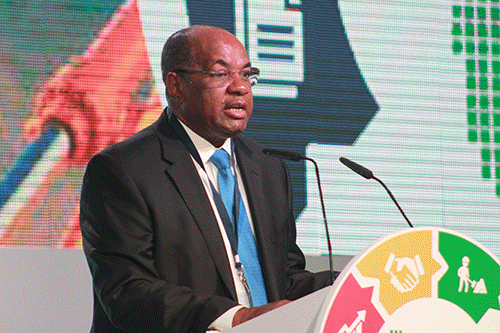As Namibia marked 31 years of independence, Bank of Namibia governor Johannes !Gawaxab addressed a public lecture under the topic: ‘How does Namibia stack up? – our own story’.
The public lecture narrated Namibia’s success story through the lens of three decades of independence and self-rule, underscored by global accredited rankings on major governance and development indices and socio-economic indicators achieved to date.
The public lecture was held on Friday, 26 March 2021, at the University of Namibia’s Oshakati campus as part of the governor’s series of stakeholder engagements.
Reflecting on some of the country’s socio-economic growth indicators since 1990 to 2020, !Gawaxab indicated that Namibia now boasts a real GDP of N$134 billion, compared to N$50 billion at independence.
Equally, the GDP per capita moved from N$33 000 in 1990 to N$54 000 in 2020. Similarly, poverty incidence levels reduced drastically from 69.3% to 17.4% in the same period. During the period under review, inflation was well contained, averaging 5.5% during the last two decades while inflation has been below 4% since mid-2019.
These gains have been recorded because of a combination of macroeconomic policies adopted by government and the drive of relevant stakeholders, which have transformed the country from a pariah state at independence into a modern state that punches above its weight on the continent. Namibia, the governor enthused, stacks up against major players on the continent and can hold its own and compete.
This, he said, is evident in terms of effective governance that it is a pre-requisite for economic development and advancement. For instance, the country continues to perform well on the Mo Ibrahim Foundation Good Governance Index coming in the 7th position out of 54 African countries on overall governance in 2020. Equally, on global competitiveness Namibia ranks into the top five sub-Saharan African countries as per the World Economic Forum Competitiveness Report of 2019. Similarly, the Human Development Index indicates that Namibia is number 5 among the same countries.
!Gawaxab continued that Namibia has made considerable strides in relation to infrastructural development, with the percentage of the Namibian population that has access to electricity and potable water increasing substantially to 53.9% and 84%, respectively.
In terms of Logistics Performance Indicators, Namibia is rated 5th amongst sub-Sahara African countries. Relatedly, Namibia remains unchallenged in Africa in terms of road infrastructure development in 2020, coming in first place.
The governor also mentioned that Namibia has a large, complex and robust financial system, made up of a balance of commercial banks and non-bank financial institutions.
“The strong Namibian financial sector boosts confidence for Namibians and investors alike amid challenges. There are high capital and reserve buffers, with banks’ minimum required capital as percentage of risk-weighted assets having been increased from 4.5% in 1990 to 10% in 2020 and actual capital and reserves nowadays standing at 15%. The non-performing loan ratios have remained below 7% since the turn of the millennium.
Additionally, on financial inclusion, the governor also observed that the latest results from the Namibia Financial Inclusion Survey (NFIS) indicate the country’s banked population increased to 67.9% in 2017, up from 45% in 2011, while 78% of Namibian adults are financially included. As a result, Namibia is now ranked in 4th position in the SADC region in terms of financial inclusion.
Another feather in the proverbial hat is one of the highest levels of contractual savings on the continent that can be leveraged to provide impetus for strong and sustainable development. For instance, the retirement fund’s asset value including insurance policies stood at N$178 billion or some 103% of GDP at the end of 2020. It is common course that 40-50% of this contractual savings are invested in the local economy with the remaining about 50-60% invested in foreign markets, including the Common Monetary Area (CMA) and the rest of Africa.
Furthermore, Namibia has made significant strides in addressing the distribution of income since independence in 1990. Namibia’s efforts to reduce poverty have yielded fruits as the poverty ratio decreased significantly since 1990 in response to people finding gainful employment and government providing a safety net through social security payments. However, !Gawaxab emphasised that the country needs to redouble its effort to further reduce poverty and income inequalities.
Until recently, Namibia’s real GDP growth has been strong. The GDP has been growing at an average rate of 3.5% per annum since independence. However, the weak growth in recent years resulted from factors such as major investment projects coming to an end, low government revenue and fiscal consolidation measures aimed at strengthening long-term macro- stability, a weak global economy, the effects of the Covid-19 pandemic as well as persistent drought in prior years.
While narrating these positive trends that are a cornerstone for reimagining and repositioning the country’s future, the governor was also quick to acknowledge challenges that beset the country. These include constrained fiscal space, a low growth environment, a lack of diversity of exports, high unemployment and skills mismatches, amongst others.
Finally, the governor instilled hope that current challenges are surmountable and can be addressed, through several targeted interventions such as the newly minted Harambee Prosperity Plan II: “We are mindful that investments in agriculture, green energy and technology, as well as general structural reforms and confidence in the economy are key for the success of the Namibian story now and beyond. But we can assert with all boldness and confidence that we are a nation on the move”.


